Chasserades in Lozere |

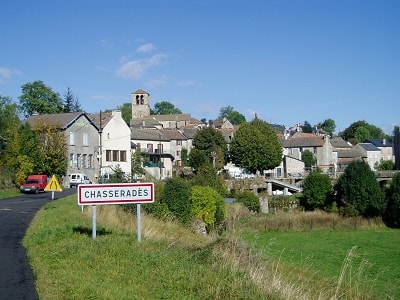 Chasseradès is a French commune located in the Lozère department in the Occitanie region. It is situated in the Cevennes and has about 200 inhabitants. Chasseradès is known for its historical heritage, notably its Romanesque church from the 12th century, as well as its preserved natural setting, with mountain and forest landscapes suited for outdoor activities such as hiking. The commune is also located near tourist attractions such as Mont Lozère and the Tarn gorges. Chasseradès is a preferred destination for those seeking tranquility and the beauty of the natural landscapes of the Cevennes.
Chasseradès is a French commune located in the Lozère department in the Occitanie region. It is situated in the Cevennes and has about 200 inhabitants. Chasseradès is known for its historical heritage, notably its Romanesque church from the 12th century, as well as its preserved natural setting, with mountain and forest landscapes suited for outdoor activities such as hiking. The commune is also located near tourist attractions such as Mont Lozère and the Tarn gorges. Chasseradès is a preferred destination for those seeking tranquility and the beauty of the natural landscapes of the Cevennes.
Chasseradès is a small vacation and rest village surrounded by meadows and woods on the watershed. It is located 13 km from La Bastide-Puylaurent on the Stevenson Path which extends towards Mirandol and then to Estampe. The small train of the SNCF railway line connecting La Bastide to Mende stops at Chasseradès. There is currently a small grocery store, a hotel-restaurant, and a guesthouse in the village center.
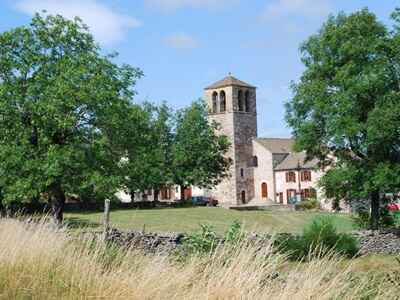 The imposing Saint-Blaise church stands in the square at the top of the village. A massive square tower that dominates the Chassezac valley and faces the Goulet mountain. Its Romanesque construction is from around the 12th century. Our Lady of Chasseradès. Today, under the invocation of Saint Blaise, the church was in the Romanesque period dedicated to Our Lady.
The imposing Saint-Blaise church stands in the square at the top of the village. A massive square tower that dominates the Chassezac valley and faces the Goulet mountain. Its Romanesque construction is from around the 12th century. Our Lady of Chasseradès. Today, under the invocation of Saint Blaise, the church was in the Romanesque period dedicated to Our Lady.
It is a monastic foundation, the vast sanctuary of an important priory that later became the property of the clergy of Mende. The building is mentioned in 1227. Although remodeled and having undergone additions that modify its Romanesque silhouette, this church remains very interesting and characterized by its similarity to those of La Garde Guérin, Prévenchères, and Puylaurent.
Recent developments of the village square, staircases, and access to the building have further modified it, particularly in its "village fabric." It is classified as a historical monument. The nave, which has been enlarged, has five vaulted arches in a full semicircle. The double arches of the first bays (the closest to the apse) rest on engaged columns with sculpted capitals; the others rest on pilasters or on corbels.
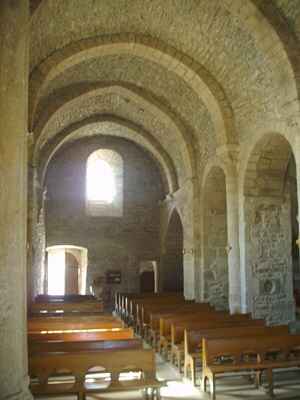 The original plan, which was limited to the first bays of the nave and the choir, has been modified by the extension of the nave and the addition of a northern collateral and a ribbed chapel that flanks the apse. Before the opening of this collateral, the lateral walls of the nave were to be animated by wall arcs in full semicircle. The builder has particularly cared for the supports of the fully rounded triumphal arch with a double roll, which gives access to the sanctuary proper, according to a layout similar to that observed in La Garde Guérin, Prévenchères, and Puylaurent.
The original plan, which was limited to the first bays of the nave and the choir, has been modified by the extension of the nave and the addition of a northern collateral and a ribbed chapel that flanks the apse. Before the opening of this collateral, the lateral walls of the nave were to be animated by wall arcs in full semicircle. The builder has particularly cared for the supports of the fully rounded triumphal arch with a double roll, which gives access to the sanctuary proper, according to a layout similar to that observed in La Garde Guérin, Prévenchères, and Puylaurent.
To the southwest of Chasseradès stood the castle of Mirandol, whose name indicates the wide view it offers. It was the seat of an important lordship (one of the twelve lordships or noble households of Gévaudan). In the Romanesque period, it was held by "the ancient chivalry of Naves." Guillaume de Naves was in 1207 a godfather of La Garde Guérin. Guérin de Naves, lord of Mirandol, was a witness in 1267 to a tribute paid to Guigues, the baron of Tournel. A little further west, along the small asphalt road lined with granite crosses, we reach Saint Frézal d'Albuges.
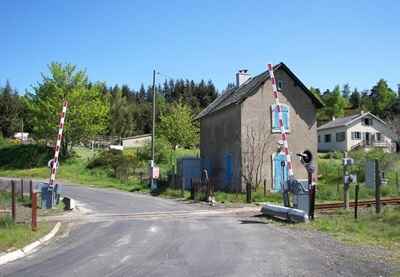 The train that connects Mende to La Bastide-Puylaurent via Allenc and Belvezet always stops at the small station located about 1 km from Chasseradès. The line is often blocked by snow in winter, and protective tunnels had to be built. It is an excellent means of inexpensive transport, very pleasant and unique in France. You can also take your bike on the train. To signal a stop, you must indicate your presence on the station platform with a large hand signal. The viaduct of Mirandol is very impressive; it overlooks the Chassezac river, which already takes the form of a small canyon and which further towards La Garde-Guérin will transform into imposing gorges. (See the Chassezac Gorges). The Chassezac springs from Moure de la Gardille like the Allier (watershed).
The train that connects Mende to La Bastide-Puylaurent via Allenc and Belvezet always stops at the small station located about 1 km from Chasseradès. The line is often blocked by snow in winter, and protective tunnels had to be built. It is an excellent means of inexpensive transport, very pleasant and unique in France. You can also take your bike on the train. To signal a stop, you must indicate your presence on the station platform with a large hand signal. The viaduct of Mirandol is very impressive; it overlooks the Chassezac river, which already takes the form of a small canyon and which further towards La Garde-Guérin will transform into imposing gorges. (See the Chassezac Gorges). The Chassezac springs from Moure de la Gardille like the Allier (watershed).
The fauna and flora of the Chasseradès region are very diverse. You can observe deer, wild boars, wolves, lynxes, birds of prey, and a multitude of birds.
Deer are the most common animals in the region. They are found in forests and meadows. Wild boars are also present in the region. They are often seen along the roads. Wolves have returned to the Cévennes in recent years. They are present in mountainous areas. Lynxes are rarer, but can be observed in the region's forests. Birds of prey are very numerous in the Cévennes. You can see vultures, eagles, falcons, and kites. The region is also rich in birds. You can observe songbirds, birds of prey, and waterfowl.
 The village is mentioned for the first time in a document from the 12th century. It was then an important commercial and religious center. In the 16th century, Chasseradès was affected by the religious wars. The village was burned and looted by the Protestants. It was rebuilt during the 17th century.
The village is mentioned for the first time in a document from the 12th century. It was then an important commercial and religious center. In the 16th century, Chasseradès was affected by the religious wars. The village was burned and looted by the Protestants. It was rebuilt during the 17th century.
On September 27, 1878, Robert Louis Stevenson shared a room at the old inn located in the very center of Chasseradès. He met the officials responsible for the measurements in view of the construction of the viaduct, but the line was not opened until 24 years later. This line is one of the most picturesque in France, serving places where one can go in search of menhirs, dolmens, rocks with cupules, montjoies, ancestral paths used since antiquity by crusaders, transhumants, muleteers... and hikers.
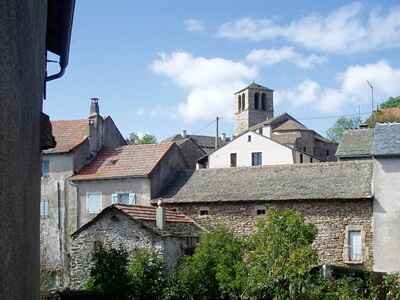 A very beautiful place for hiking, cycling, trout fishing, and mushroom picking. The muleteers would come from the south with wine, olive oil, and salt to exchange them for straw, fodder, cheese, salted meat, cereals, and legumes like lentils, wheat, rye, barley, etc.
A very beautiful place for hiking, cycling, trout fishing, and mushroom picking. The muleteers would come from the south with wine, olive oil, and salt to exchange them for straw, fodder, cheese, salted meat, cereals, and legumes like lentils, wheat, rye, barley, etc.
"At the end of an hour, I saw the village, perched on a rock, above a bend in the Chassezac. I arrived at the bridge and stopped to contemplate the landscape. The village was surrounded by mountains and forests. The houses were made of stone and wood. In the distance, I could see the snow-capped peaks of Mont Lozère. I crossed the bridge and made my way to the village. The inhabitants were curious to see this Scot accompanied by a donkey. They stopped me in the street to ask me questions. I felt like a celebrity. I found an inn and settled in. I asked the landlady if she knew a place where I could leave Modestine. She told me there was a meadow near the river. I gave her Modestine's lead, and I let her graze.I walked around the village. I saw the church, the town hall, and the market square. I met locals who invited me to have a glass of wine. I spent a pleasant evening in Chasseradès."
 "I left Chasseradès in the morning and headed towards Mirandol. The hike was difficult at first, but it became easier as I progressed. I crossed forests, meadows, and mountains. I passed picturesque villages and isolated hamlets. I met locals who were always welcoming and helpful. I was surprised by the beauty of the landscapes. The mountains were snow-covered, the forests were lush, and the rivers were clear. I felt like I was in a dream.
"I left Chasseradès in the morning and headed towards Mirandol. The hike was difficult at first, but it became easier as I progressed. I crossed forests, meadows, and mountains. I passed picturesque villages and isolated hamlets. I met locals who were always welcoming and helpful. I was surprised by the beauty of the landscapes. The mountains were snow-covered, the forests were lush, and the rivers were clear. I felt like I was in a dream.
I arrived in Mirandol in the evening. I was welcomed by the village mayor, who offered to provide me with a room and a meal. I spent a good night in Mirandol. The next morning, I resumed my hike. I headed toward Estampe. The hike was easier than the day before. I arrived at Estampe in the late afternoon. I was welcomed by the village priest, who offered to provide me with a room and a meal.
I spent a second good night in the Cévennes. I was impressed by my journey from Chasseradès to Mirandol and Estampe. I discovered beautiful landscapes and met welcoming locals. I spent two unforgettable days in the Cévennes."
Across the way, the Goulet state forest stretches over more than 1,000 hectares, between 850 and 1,500 m in altitude. It is in the Goulet massif that the Lot springs. In winter, the snow takes possession of the little road that winds up to reach Bleymard. One must then take the detour through Belvezet. There, the ear may be called upon by "a sound similar to that of a large bumblebee heard from several miles away... caused by a shepherd leading his flock to the sound of a trumpet." The narrow street of L'Estampes, from one end to the other, overflowed with black and white sheep, bleating together like birds sing in spring... it made for an impressive concert all in high notes."
Former holiday hotel with a garden along the Allier, L'Etoile Guest House is located in La Bastide-Puylaurent between Lozere, Ardeche, and the Cevennes in the mountains of Southern France. At the crossroads of GR®7, GR®70 Stevenson Path, GR®72, GR®700 Regordane Way, GR®470 Allier River springs and gorges, GRP® Cevenol, Ardechoise Mountains, Margeride. Numerous loop trails for hiking and one-day biking excursions. Ideal for a relaxing and hiking getaway.
Copyright©etoile.fr